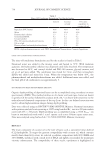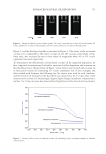703 UV OXIDATION dark. The degradation measured after the 3 h exposure period was 16%. Over a 24 h exposure period, 52% degradation was observed (Figure 2). Experiments were then performed with iron chloride salts to understand the role of redox metals in ROS formation. Increased tyrosine degradation was found, but iron levels greater than 100 ppm were needed because of the lower solubility of chloride salts in the PEG– Tyr micelles. Thus, two hydrophobic iron(III) salts that can localize into the polymer micelles were used, namely, iron(III) stearate [Fe(stearate) 3 ] and iron(III) acetylacetonate [Fe(acac) 3 ]. The percentage tyrosine degradation was measured over 24 h as a function of added Fe(stearate) 3 . Even at very low metal concentration (0.1 μg/g), the degradation was found to be significantly higher than in the metal-free systems (Figure 3). This iron salt 3 h 24 h 0 10 20 30 40 50 60 70 80 90 100 Figure 2. Tyrosine degradation upon UV exposure of a 10 mg/mL PEG5000–Tyr10 aqueous micellar solution, measured in terms of the decrease in tyrosine fluorescence relative to that of a control sample. Figure 3. Effect of the Fe(stearate)3 concentration (expressed as the Fe:Tyr ratio) on tyrosine degradation in PEG2000–Tyr5 micellar systems at 2 mg/mL, measured in terms of the decrease in tyrosine fluorescence over 24 h of UV exposure. yrfuoescenceost T %
704 JOURNAL OF COSMETIC SCIENCE was found to have less of an impact on degradation at higher concentration because of its lack of solubility. The role of oxygen was then investigated by comparing the rates of tyrosine degradation and dityrosine formation in both a metal-free polymer system (PEG 5000 –Tyr 10 ) and a polymer system (PEG 2000 –Tyr 5 ) containing 0.5 ppm Fe(III) as either stearate or acetylacetonate. The solutions were degassed and then sealed and irradiated for 24 h before being analyzed by fluorometry (Table I). In terms of tyrosine oxidation, both metal-containing systems were less affected by the exclusion of oxygen than the metal-free system. This indicates that direct metal–tyrosine interactions play a role in Tyr degradation. Furthermore, the system containing Fe(stearate) 3 was much less influenced by the exclusion of oxygen. This is likely because, in this case, the iron was immobilized within the micelle and the direct interaction between iron and tyrosine was significantly enhanced, contributing to more overall degradation. Excluding oxygen therefore has less of an impact for Fe(stearate) 3 than for Fe(acac) 3 , for which increased activity primarily arises from increased ROS production. Although dityrosine formation was found to occur in the absence of oxygen, in agreement with the literature (25), its formation was significantly suppressed under oxygen-free conditions. This is indicative of a lower radical yield, as excited-state tyrosine cannot transfer an electron to molecular oxygen. Despite increased dityrosine formation compared to the metal-free system, the iron(III) samples were affected in a similar way when air was removed. This suggests that metal complexes are not effective electron acceptors and increased activity through direct metal–tyrosine interaction could therefore arise from the photosensitization of tyrosine by metal complexes. To determine whether antioxidants could reduce tyrosine degradation, BHT was identified as a suitable candidate because it is relatively hydrophobic and acts by donating the phenolic proton to quench peroxyl radical species. This creates a phenoxyl radical that is stabilized through conjugation to the aromatic ring and steric hindrance provided by the tert-butyl groups in ortho positions (26). BHT was found to have a significant impact on the observed photodegradation of tyrosine over a prolonged exposure period in a metal-free system and when iron(III) was present as stearate and acetylacetonate complexes (Table II). However, the different iron complexes exhibited notably different responses to the antioxidant. Both metal-free and Fe(acac) 3 systems show a rapid drop-off at low antioxidant concentration indicative of BHT effectively quenching peroxyl radicals, thus breaking the autoxidation cycle. By comparison, addition of a low concentration of BHT to Fe(stearate) 3 -containing samples results only in a modest decrease in activity, as also seen in air-free experiments because of the direct interaction between the metal and tyrosine. Table I Percentage Loss of Photochemical Activity in Air-Free Samples, Compared to Identical Samples in Air* PEG5000–Tyr10, no metal PEG2000–Tyr5, 0.5 ppm Fe(stearate)3 PEG2000–Tyr5, 0.5 ppm Fe(acac)3 Tyr degradation 94 18 89 Dityrosine formation 87 93 95 *Based on fluorescence data, rounded to the nearest whole number.
Purchased for the exclusive use of nofirst nolast (unknown) From: SCC Media Library & Resource Center (library.scconline.org)






































































































































